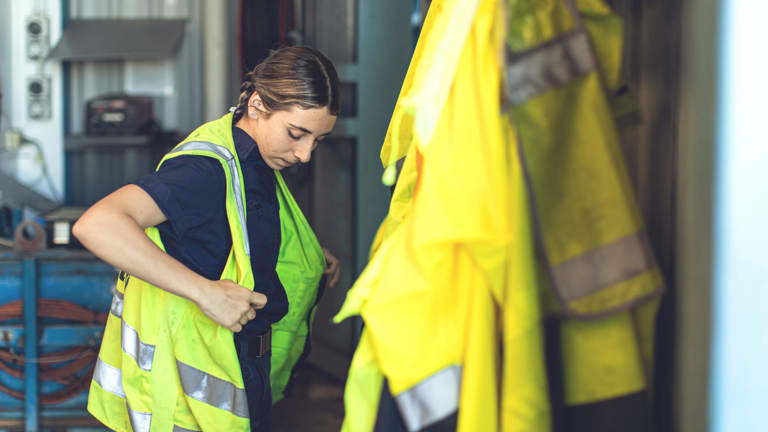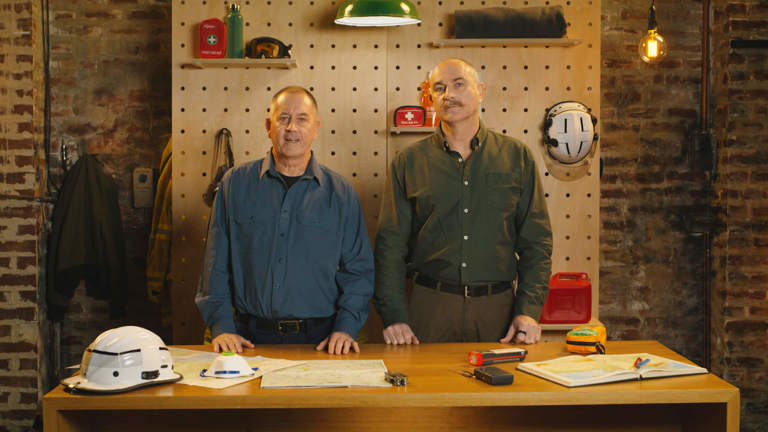When it comes to bushfire preparation, home maintenance is key.1
“Having your property well prepared for bushfire will give it the best chance of survival and being defensible by firefighters,” explains Jim Smith, volunteer firefighter and former Deputy Commissioner of Fire and Rescue NSW.
But it’s important to note that thorough bushfire preparation isn’t only about those big jobs outside of your home. There are lots of things you can do this weekend to start getting your home ready for bushfire season.
Putting together a bushfire survival plan with your family or household members is just as important as home maintenance, says Jim.
“One of the most common mistakes Australians make when it comes to bushfire preparation is not having a real bushfire survival plan and relying on a ‘wait and see’ response.”

“Not having a bushfire survival plan in place can lead to panic, and this is when wrong decisions such as leaving at the wrong time can happen.”
Jim stresses the ‘be prepared’ message isn’t just for people who live on country or rural properties.
“Don’t be complacent just because you live in a built-up suburban area,” he says. “You still need to be just as well prepared as somebody who lives out in the bush.”
5 jobs to begin your bushfire preparation
TapHover over the hotspots below to see the jobs to be done.


Repair any cracks or gaps in your roof or cladding. Flying embers can enter small gaps and start fires.

Clear leaf litter and debris from your lawn. Keep your grass short.

Remove any leaf litter or twigs from your gutters. Consider installing metal gutter guards if you are in a bushfire-prone area.

Move flammable objects such as woodpiles, hanging baskets and wooden outdoor furniture away from your home.

Remove fine, flammable mulch from garden beds against the house. Try non-combustible options such as pebbles, shells or decorative gravel.
When should you start preparing for bushfires?
The best time to prepare your home is now, while time is on your side.
“It’s too late to cut back vegetation and clear up huge piles of roof and ground litter when the bushfire is approaching,” says Jim.
According to the Bureau of Meteorology, northern parts of Australia experience peak bushfire activity during the dry winter and spring months, while in southern parts of the country, bushfire season peaks in summer and autumn.
However, it’s important to remember that while these are traditionally the riskiest times of bushfire season, local conditions can drive dangerous bushfire activity at any time.2
Find local advice from official government resources for your region using the list below:
- Australian Capital Territory
- New South Wales
- Northern Territory
- Queensland
- South Australia
- Tasmania
- Victoria
- Western Australia
“The commencement of bushfire danger periods in your area is a good trigger for you to start preparing your property, removing ground litter and roof litter, cleaning gutters and moving combustibles from your home,” explains Jim.
“This will also be the time to review your bushfire survival plan and begin monitoring fire service sites for alerts and warnings, and monitor weather and fire danger ratings.”
Bushfire preparation jobs to do this weekend
Getting started on bushfire preparation ahead of the fire season can involve both indoor and outdoor jobs.
If you live on a semi-rural or rural property, Jim says this weekend is a good time to check and maintain your firefighting pumps, water systems and, importantly, your generators.
“I turned up at a house once when a fire was on its way, and there were people there who were obviously fairly new to the land – maybe hobby farmers – and they were standing there going, ‘We’ve got our electric water pump, but we’ve lost power’,” says Jim.
“So, we picked them up, took them out of the area and put a fire engine there.”
If they hadn’t been able to get the fire engine to the property, their homes and lives would have been at serious risk, adds Jim.
Indoor jobs to do this weekend
- Gather sufficient personal protective clothing and equipment for all members of your family or household, and store these items where they’re readily accessible.3
- Stock your first aid kit.4
- Check your home and vehicle insurance is adequate and up-to-date.
- Make note of your Neighbourhood Safer Place, if available.
- Check your local government and state fire service websites for helpful apps.
- Familiarise yourself and your family with the Australian Fire Danger Rating System.5
Outdoor jobs to do this weekend
- Clear gutters and roof of leaves, twigs, bark and other debris.
- Point any LPG cylinder relief valves away from your home.
- Reduce vegetation along access paths and trim branches around your home that are less than two metres above the ground.6
- Mow your lawn.
- Check and maintain firefighting pumps, generators and water systems, if applicable.
Bushfire preparation jobs to do this month
One of the most important steps to prepare your home for bushfire season is to create and properly document your bushfire survival plan. If you already have one, you may wish to review and update it. Include your whole family or household, so they’re aware of any changes.
“In reality, not many people actually do a bushfire survival plan,” says Jim.
“If you do a survey, you’ll probably have 70 or 80% of people say they do, but they don’t. They have one in their mind (but) they never actually put it on paper. They never actually sit down and work out their triggers to leave.”
Outside, take the time to identify and mark any water sources for firefighters, such as a swimming pool or any water tanks or dams on your property. In NSW, the Rural Fire Service and Fire and Rescue (FRNSW) provide free Static Water Supply (SWS) signs for properties with suitable water supplies.7
“It makes it so much easier for firefighters,” Jim adds.
While you’re outside, consider minimising or removing any flammable or hazardous items near your home, such as woodpiles and mulch.
“The (2003) Canberra fires showed that much of the house destruction was from house-to-house transference and ember attack,” says Jim.
“Mulch close to buildings quickly caught on fire and assisted fire spread from home to home. Use mulch only in gardens away from your home or structure – removing all combustibles that are close to your home will greatly aid your home’s chance of survival.”
Indoor jobs to do this month
- Sit down with your family or household members to create your bushfire survival plan.
- If you already have a bushfire survival plan, review and update it together.
- Prepare a bushfire emergency kit, ensuring you have adequate supplies if you need to evacuate or if you’re not able to leave in time.8
- Ensure your pets are properly identified with a name tag or microchip (check your details are up to date on your state or territory microchip registry). If you have livestock, make sure stock registers for your livestock are current.
Outdoor jobs to do this month
- Where possible, enclose open areas under decks and floors where embers may enter and start fires (ensure any changes meet your local building codes).
- Minimise or remove any flammable or hazardous items near your home, such as woodpiles, boxes, hanging baskets and outdoor furniture.
- Install metal guards on guttering.
- Repair gaps in the roof and external cladding – embers can get through gaps as small as 2mm.9
- Check your house number is displayed clearly at the road.
- Ensure there is adequate space for fire trucks to access your home (of at least four metres in width and height, with a turn-around area.)
- If you have a pool, a tank or a dam, put an SWS sign at the entrance to your property. In NSW, the Rural Fire Service and FRNSW provide free SWS signs for properties with suitable water supplies.7
Bushfire preparation jobs to do this year
Some larger jobs around the house might not be possible to complete before this bushfire season, but you could think about putting them on your to-do list to be completed as soon as possible.
If you’re planning to renovate, it’s worth considering the materials you may use – especially if you live in a bushfire-prone area.
“I remember one house we visited in the Blue Mountains, and it had a concrete roof and walls, fire shutters on the windows, a sprinkler system and an in-ground concrete tank,” says Jim.
“They were in the bush, but this place became a fire bunker.”
Indoor jobs to do this year
- Check your bushfire emergency stockpile kit for any expired food and replace as necessary. It’s also a good idea to test spare batteries and electrical equipment annually.
- Let family members know about any changes you have made to your bushfire survival plan.
- Check your home and vehicle insurance coverage and update as necessary.
Outdoor jobs to do this year
- Replace damaged or missing roof tiles.
- Install steel or aluminium wire mesh screens on windows, doors, vents and weep holes.
- Consider using bushfire-resilient materials for upcoming renovations or additions.
How building standards have changed
The 2020 Royal Commission into National Natural Disaster Arrangements highlighted that land-use planning and building regulations can impact the risk of exposure to natural hazards.10
If you’re building in a bushfire-prone area, you’ll need the bushfire attack level (BAL) of your dwelling assessed.11
This is also important to understand if you’re looking into bigger home improvements, such as simplifying your roof line and house outline, that may help make your home more resilient to bushfires.
“If you lose your house to a fire, then you may have to put in a development application (to rebuild) through the council, and the fire standards may have changed,” says Mark Dobson, firefighter and volunteer team manager at Disaster Relief Australia.
If you’re building or renovating, other ways to reduce bushfire risk may include:10
- Using suitable non-combustible or low-combustible materials in construction
- Ensuring gaps, including vents and weep holes, are less than 2mm
- Establishing a clear asset protection zone with reduced fuel loads around your dwelling.10
For firefighters like Jim, Australians who prepare for bushfires are not only helping themselves, they’re also making the job easier for the firefighters who come to their aid – many of whom are volunteers.
“Having your property well prepared for bushfire will give it the best chance of survival and for being defensible by firefighters.”

For more expert tips to help you get bushfire ready, visit our you.prepared emergency content hub.
Jim Smith & Mark Dobson
With a combined firefighting history of more than 60 years, Jim Smith and Mark Dobson are leading members of Australia’s firefighting community. Their experience encompasses major bushfire events, including the Canberra Bushfires in 2003, Black Saturday in 2009 and the Black Summer fires of 2019-20. The pair now work together in their respective roles as General Manager and Founder of Ordinary Courage, a consultancy dedicated to providing organisations with the tools to sustain good workplace mental health. Youi is proud to partner with Jim and Mark in the creation of this bushfire preparedness content.
The content in this article has been prepared based on current government and emergency services guidelines and expert advice provided at the time of publishing. This information is subject to change. Please be sure to check for the latest information and always consider your personal circumstances regarding bushfire preparedness and response.
Where you have increased your cover or reduced your excess within 72 hours (or other period noted on your policy schedule) of a flood, storm, hail or bushfire occurring, cover will be limited to the amount that was effective prior to the change. Loss, damage or legal liability caused by, resulting or arising from flood, storm, hail or bushfire during the first 72 hours (or other period noted on your policy schedule) of your policy first being purchased is excluded unless certain conditions apply. Refer to the relevant PDS, TMD and your policy schedule for full T&Cs.
1 Source: National Emergency Management Agency – Bushfire preparation key as flooding fuels fire, August 2023
2 Source: Bureau of Meteorology – Bushfire weather
3 Source: NSW Rural Fire Service – What to wear
4 Source: Australian Government Health Direct – First aid kits
5 Source: National Council for Fire and Emergency Services – Australian Fire Danger Rating System
6 Source: SA Country Fire Service – Preparing your home & property
7 Source: NSW Rural Fire Service – Static Water Supply (SWS)
8 Source: SA Country Fire Service – Emergency kits
9 Source: Vic Government – Siting and general design considerations, September 2023
10 Source: Australian Government – Bushfire protection
11 Source: Housing Industry Association – Construction of buildings in bushfire prone areas



